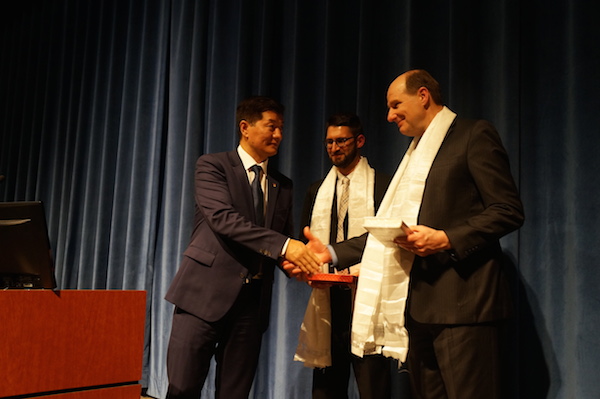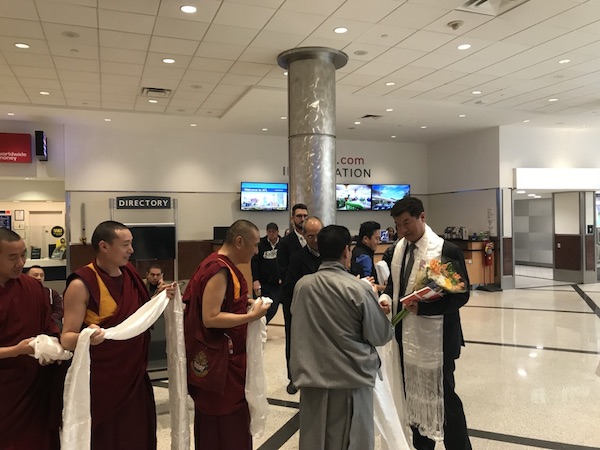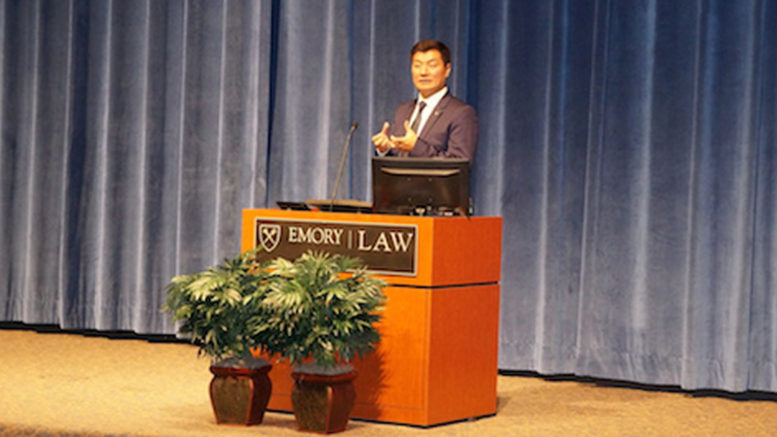ATLANTA, GA: President of the Central Tibetan Administration Dr Lobsang Sangay delivered the 2018 Harold J. Berman Distinguished Lecture in Law and Religion at the prestigious Emory University in Atlanta. He delivered the lecture on the topic ‘The Tibetan People’s Transition to Secular Democracy’ to a rapt audience of scholars, students and professors.
In the lecture, President Dr Lobsang Sangay claimed that Tibetan democracy is one of the most unique and interesting democratic systems in the whole world that is a result of the strides made by the Tibetan people led by His Holiness the Dalai Lama over the last six decades.
Dr Sangay further admitted that we are living in a world, which is increasingly turning more nationalistic and extremist, and hence, the successful transition to a secular democracy by the Tibetan people in such a time is even more noteworthy.
Dr Sangay outlined four key features of Tibetan democracy that makes Tibetan democracy unique among others.
“Tibetan democracy is multi-dimensional. Unlike most other democracies, it evolved as a top-down initiative while most other democracies were a down-up struggle,” he began. “In fact, His Holiness the Dalai Lama had to politely refuse the Tibetan people’s request in 2010 and force his decision to fully democratise the Tibetan polity, which in itself is unusual,” he added.
“As a result, the political authority vested in His Holiness the Dalai Lama is devolved to an elected leadership in 2011 which happened to be me at the time,” he said.
Explaining the four salient features of Tibetan democracy, he said that while democracy in itself is one of the most popular forms of governance for a long time, the concept is not without contradictions in the Tibetan context.
Firstly, he noted the contradiction of democracy and the goals of an exile administration. “Tibetan democracy is an exile administration. In an exile administration, the emphasis is usually on unity, a single leader and a single voice. It is understandable because the purpose is to return. Unity is paramount in such exile set-ups. Once it is a democracy, there is a contradiction because in a democracy, instead of unity, you have to support diversity. Instead of a single leader, there are oppositions. Instead of a single voice, you must have freedom of speech. Hence it is very unique and challenging,” he said.
Explaining the second unique feature of Tibetan democracy, he said: “It is said that the Tibetan people originated from the union of a monkey and a rock ogress in the valley of Yarlung. It is again believed that the monkey is a manifestation of Avalokiteshwara, the Buddha of compassion. We also believe that all the Tibetan kings were manifestations of Buddha. And the reign of the successive Dalai Lamas in Tibet as both spiritual and temporal leaders further strengthened our bond with spirituality. So, Tibetan people and spirituality is intricately linked. In that sense, the democratisation of the Tibetan polity in 2011 is not only a big transition; it is a drastic departure from past practice.”
He noted the third unique feature of Tibetan democracy as its ability to exist without a physical border. “One of the most important feature of democracy is the need for a state. However, Tibetan democracy is without a physical border or a state.”
“As an exile administration, the Tibetan administration doesn’t have a state. The Tibetan refugee community is scattered across the world. So, when the Tibetan cabinet makes a decision, they send the notice to Tibetans around the world and it is followed by all, irrespective of the size of the Tibetan community in the place. You have to realise that we don’t have a police to enforce the decisions, nor do we punish anyone if the decisions are not followed and yet it is followed by all without fail,” he said.
He attributed the final and fourth key feature of Tibetan democracy as the Tibetan people’s embrace of democratic values from an early stage in exile.
“There are over 60 million refugees in the world. However, it is only the Tibetans who are exercising democracy. As a matter of fact, when we came into exile, the first major reform that His Holiness the Dalai Lama spoke about was a democratisation of the Tibetan polity.”
“Now, after more than five decades, the democratic Tibetan administration is well established. We have an exile government, which is rooted in the harmony of the three pillars of democracy: the Judiciary, the legislative and the executive. It is also the most frugally and efficiently run administration in the world,” he asserted.
The lecture was well received and ended with a standing ovation from the audience followed by a brief question and answer session.
President Dr Sangay arrived in Atlanta, Georgia on 9 April 2018. He was received at the airport by the Associate Director of Center for the Study of Law and Religion of the Emory University Mr. Silas Allard, Geshe Lobsang Tenzin Negi, Director of the Emory-Tibet Partnership and Tibetan Community Association Members of Atlanta.
Before heading to the University, Dr Sangay briefly visited a dharma center established by Drepung Loseling Monastery in the city and met members of the Tibetan Community who organised a traditional welcome reception for him at the monastery.

CTA President Dr Lobsang Sangay presenting a souvenir to Associate Director of Center for the Study of Law and Religion of the Emory University Mr. Silas Allard

The audience at CTA President Dr Lobsang Sangay’s lecture at Emory University in Atlanta.

CTA president is being welcomed at the Atlanta airport on 9 April 2018.

CTA President offering prayers at the dharma centre run by Drepung Loseling Monastery in Atlanta.

Members of the Tibetan community in Atlanta with CTA president Dr Lobsang Sangay.

